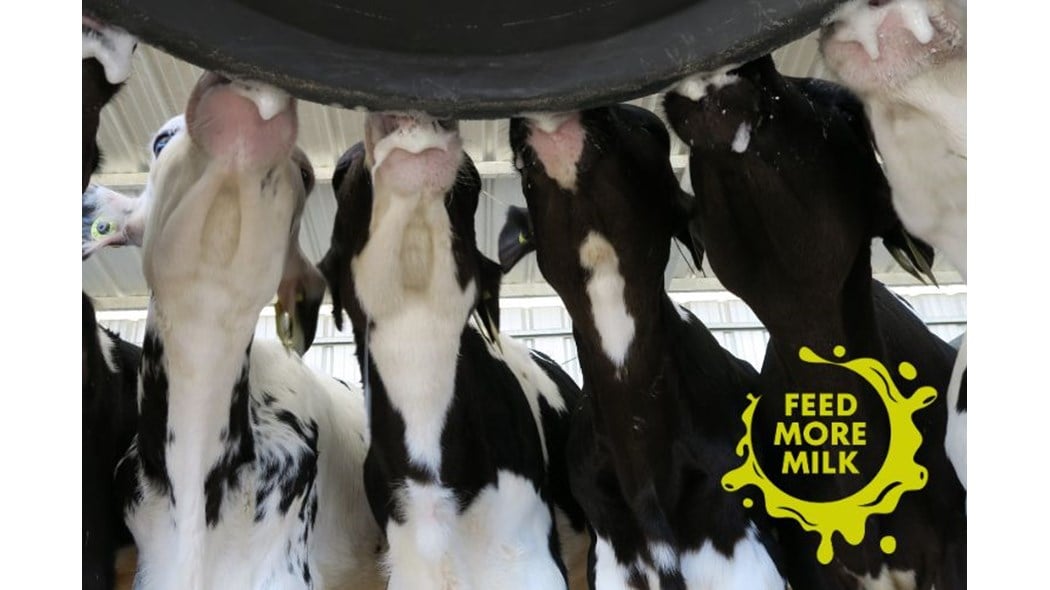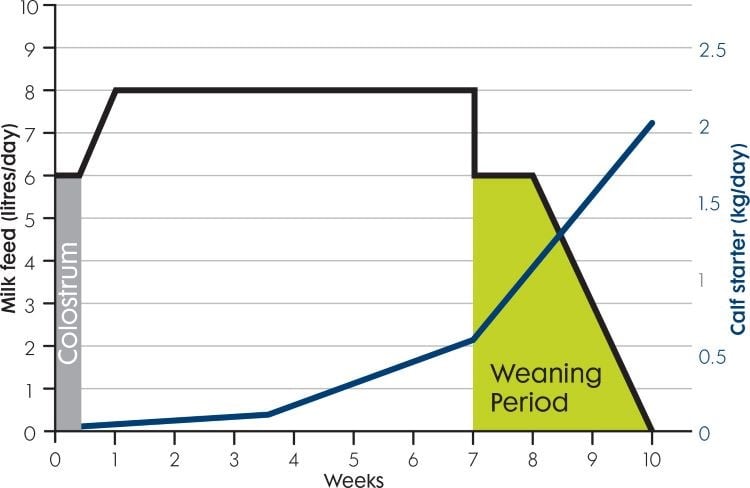Research commissioned by Trouw Nutrition asked the question, how many litres of milk or milk replacer do you feed at the high points of your feed curve? The results showed that 65% of UK dairy farmers only fed six litres or less milk replacer per calf per day, with only 11 % feeding 8 litres or more. However, in order to achieve increased health and performance, we need to feed a minimum of 8 litres a day.
Calves can be fed unrestricted levels of a quality milk replacer
Getting calves off to the best possible start and optimising pre-weaning growth are the foundations of lifelong health and performance, reduced age at first calving, lower total rearing costs and lower total farm emissions.
Feeding elevated levels of a quality milk replacer has been demonstrated to be an effective way to optimise pre-weaning performance according to Dr Laura Tennant, from Trouw Nutrition GB. She says that new research is helping dispel many of the myths surrounding how much milk replacer can safely be fed.
Dr Laura Tennant
Trouw Nutrition Young Animal Feed Technical Advisor

Feeding calves milk replacer as close to appetite as possible has been shown to optimise the of development of the key organs in calves, including the liver, kidneys, gastro-intestinal tract and mammary tissue. The milk allowance is the main driver of gut health pre- and post-weaning, and if you feed calves well, you are setting them up for the future and they will pay you back with better lifetime performance.
The usual objection raised to feeding more milk is that the abomasum can be overloaded, resulting in milk replacer getting into the rumen. However, the abomasum is actually able to significantly increase capacity allowing greater milk intakes.
Research shows that three-week-old calves will voluntarily consume up to 6-7 litres of warm milk in one meal without milk entering the rumen or any indications of abdominal pain or discomfort. So traditional beliefs about restricting the volume fed per meal to prevent the possibility of ruminal overflow are not correct and we can actually feed significantly more per meal, helping increase total daily intakes with the benefits this brings.
The abomasum actually has the capacity to accommodate fluids significantly greater than two litres at a time, acting like a stretchy ballon. Studies also show that calves have the ability to slow down the rate of abomasal emptying to control blood glucose. So the calves know how to self-regulate.
Quality is key when selecting a calf milk replacer
If calves will readily consume more milk and in so doing achieve higher total dry matter intakes then it makes sense to make the most of this opportunity. But the feeding management has to be refined to exploit the opportunity.
The starting point is to select a milk replacer formulated for feeding at unrestricted levels. The closer a milk replacer resembles cow’s milk, the more closely it will support the calf’s biology and meet its nutritional needs. Many commercially available milk replacers contain more lactose and less fat than bovine whole milk. For example. most milk replacers are typically low in fat on a dry matter basis compared to whole milk which has about 30% fat.
High lactose can be a particular problem as it accounts for 50% of the osmolality of milk replacers. Osmolality is a measure of the concentration of particles in solution and is calculated by adding the concentration of sugars such as lactose and minerals
The osmolality of cow’s milk is close to 300mOsm/kg and greatly increasing or decreasing osmolality from this target level can affect digestibility and increase the risk of gastrointestinal problems and enteric infections, including nutritional scours.
Practical advice for implementation in your calf shed
Having selected an appropriate milk replacer follow a milk feed curve and refine your calf feeding protocols. It is important to build milk intakes quickly, achieving feeding eight litres per day by the end of week one as this will help train the abomasum and develop the metabolism of the young calf.

Calves will have no problem drinking high volumes of milk. If left on the dam they would be consuming 10-15 litres/day by end of week one Feeding frequency, however, must be more than once a day. Sufficient intakes can be achieved on twice daily feeding as long as enough time between feed.
Calves should be fed using a teated bottle or bucket. Feeding from a flat-bottomed bucket with no teats will not allow high volume intakes or satisfy the suck reflex. In addition, the oesophageal grove has to work against gravity as calves will drink too fast.
The feeds need to be far enough apart to feed high volumes with ideally 12 hours between feeds. If this is not possible then look at amending portion size. Portions don’t need to be the same size in the morning and afternoon if achieving a 12-hour interval is difficult. For example, three litres could be fed at 7.00a.m. and five litres at 3.00 or 4.00 p.m.”
Weaning and dry feed intake
It is a misconception that higher milk feed rates suppress dry feed consumption. Feeding more milk in the first month will improve development of the gastro-intestinal tract leading to higher growth rates, and greater acceleration of dry feed intake once milk allowance is gradually reduced.
We advise a three-week weaning period with an initial step down in milk fed followed by a gradual decline. Calves should be eating 1kg concentrate/day at the start of weaning, building to 3-4kg/day at the end of weaning.
It is important to monitor performance and progress to ensure calves are on track. We would advise weighing calves at birth, at three and six weeks old and at weaning. Use the data to measure how well they are performing, looking for a minimum of 0.8 kg - 1kg/day DLWG. And monitor concentrate intakes closely in the run-up to weaning to ensure they are sufficient to allow calves to be weaned.
Science clearly shows the benefits of feeding more milk replacer and, with some fine-tuning of feeding management, there is no reason why it can not be adopted on all dairy units.